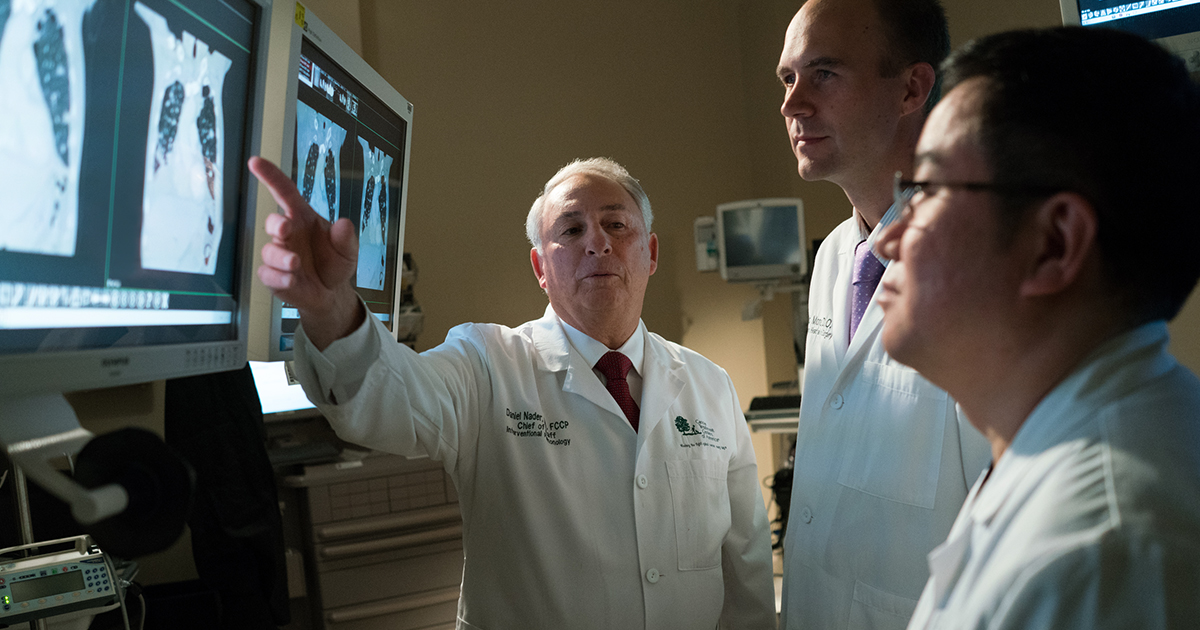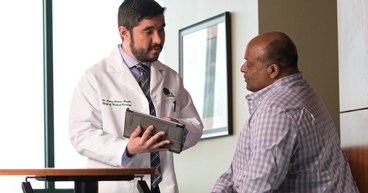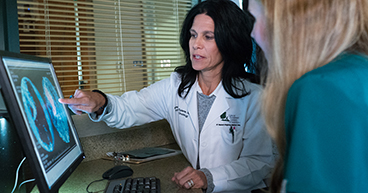
Advanced cancer can be challenging to treat, especially when it spreads to vital organs that are critical to the body’s survival, such as the liver and the lungs. The difficulty comes in not only reaching the tumor, but in treating it without damaging the vital organs affected and further harming the patient’s health. But a more targeted treatment approach is offering such patients a potential option, allowing doctors to deliver high doses of chemotherapy or radiation directly to the tumor, without exposing the rest of the body to harmful levels of toxicity. Called organ-directed therapies or regional therapies, the treatments are strategic in choosing a specific target, rather than being delivered throughout the body. “We work to manage a patient’s disease in a way that treats the place in the body where the cancer could have the worst effect,” says Pragatheeshwar Thirunavukarasu, MD, a Surgical Oncologist and Hepatopancreaticobiliary Surgeon at our hospital in Tulsa.
Regional therapies first emerged in the 1950s, after surgeons recognized the need for a safer alternative when surgery would either be highly invasive or potentially harmful to patients, or in cases where the cancer couldn’t be surgically removed. “Liver surgery is still considered the standard-of-care treatment when the goal of treatment is to remove all the cancer and the cancer can be operated on,” says Diego Muilenburg, MD, a Surgical Oncologist at our hospital near Phoenix. “Regional therapies are a good choice when surgery isn’t an option for whatever reason.”
In the case of regional therapies to the liver—generally referred to as liver-directed therapies—“it’s all about organ preservation,” Dr. Muilenburg says. “We’re trying to save as much healthy liver as we can while still killing the tumor.” The liver is a common target for regional therapies because it’s one of the most common sites for metastatic disease, it’s able to regenerate itself, and it can “take the hit,” Dr. Muilenburg says, meaning radiating a portion of the organ generally doesn’t cause the kind of harm that radiation causes to other organs.
Liver-directed therapies
Liver-directed therapies are delivered in a number of ways. The most common are:
- Hepatic artery pump: A surgeon places a tube into the hepatic artery—the main blood vessel supplying blood to the liver—and connects it to a small, implanted pump that continuously delivers chemotherapy directly to the liver.
- Hepatic chemoembolization and radioembolization: Through minimally invasive catheters placed in the groin, tiny particles are injected into the liver arteries that block the flow of blood to the tumor, shutting off its source of oxygen and the nutrients it needs to grow, while simultaneously delivering a high dose of chemotherapy or radiation directly to the tumor.
- Hepatic radiofrequency ablation and microwave ablation: The oncologist uses heat, either from a radiofrequency or microwave energy source, to burn the tumor away.
Regional therapies also allow for a treatment method called hyperthermia, where the chemotherapy is heated. Raising the temperature inside the tumor is designed to damage parts of cancer cells, which don’t tolerate high temperatures as well as healthy cells do.
Several regional therapies may be available to treat a certain cancer, but it is important that your oncologist knows how to perform all of them, and knows which option to use when, Dr. Thirunavukarasu says. For instance, a hepatic pump can’t be used to treat a liver tumor after radioembolization because the blood vessel the pump would use to deliver the chemotherapy would be clogged. “Treating every case with the same regional therapy is a one-size-fits-all approach to cancer treatment, but cancer isn’t one-size-fits-all,” Dr. Thirunavukarasu says.
Nor is cancer stagnant. It’s evolving, and regional therapies have evolved with it. Just a couple decades ago, in fact, regional therapies were considered experimental and most surgeons wouldn’t use them, says Charles Komen Brown, MD, PhD, Medical Director of Surgery and Surgical Oncologist at our hospital near Chicago. “If you think about where we were then compared to where we are now—to where many regional therapies are accepted as standard of care for certain types of cancer—regional therapy has come a long way,” he says.
Regional cancer therapies
In addition to the liver, regional therapies are used to target tumors in these areas of the body:
- The abdomen, which is a common site for peritoneal surface malignancies. Peritoneal surface malignancies involve the lining of the peritoneum, which is the thin, clear membrane that covers the abdomen. Tumors that go undetected in the appendix, rectum, colon, stomach, ovaries or other organs sometimes spread to these surfaces.
- The lungs, which are common sites for colorectal cancer, melanoma and sarcoma metastasis. The lungs may be targeted by some of the same kinds of regional therapies as the liver, Dr. Muilenburg says.
- The limbs, where regional therapies may be used to treat melanoma. In isolated limb infusion, a high dose of heated chemotherapy may be used to treat the leg or arm to avoid damage to the rest of the body.
Changes, both in our understanding of cancer and how regional therapies can be used to treat it, will continue to affect how oncologists use the treatment. In the future, Dr. Brown believes, cancer treatments that impact entire body systems, such as chemotherapy and immunotherapy drugs that travel through the bloodstream and affect cells throughout the body, will increasingly be combined with regional therapies to treat cancer. “We’re doing some of that already, by combining hepatic radioembolization with systemic chemotherapy when treating cancer in the liver, and by combining hyperthermic intraperitoneal chemotherapy (HIPEC), a type of regional therapy, with systemic chemotherapy to treat peritoneal surface malignancy,” Dr. Brown says. “I think that’s where the future is going to be.”
Of course, the ultimate goal may be to eliminate regional therapies altogether. “In the long term, it would be great if we didn’t have to do regional therapies because systemic treatments work well enough that we don’t need them anymore,” Dr. Muilenburg says. “Right now, we’re treating an area because that’s the only place we see cancer. But in some cases, the cancer has already spread elsewhere in microscopic amounts that can’t be detected with diagnostic tools. It would be better if we could treat the body systemically and target all the metastatic cancer cells opposed to targeting these localized areas, but for now, such treatments are limited to a few specific cancer types.”



